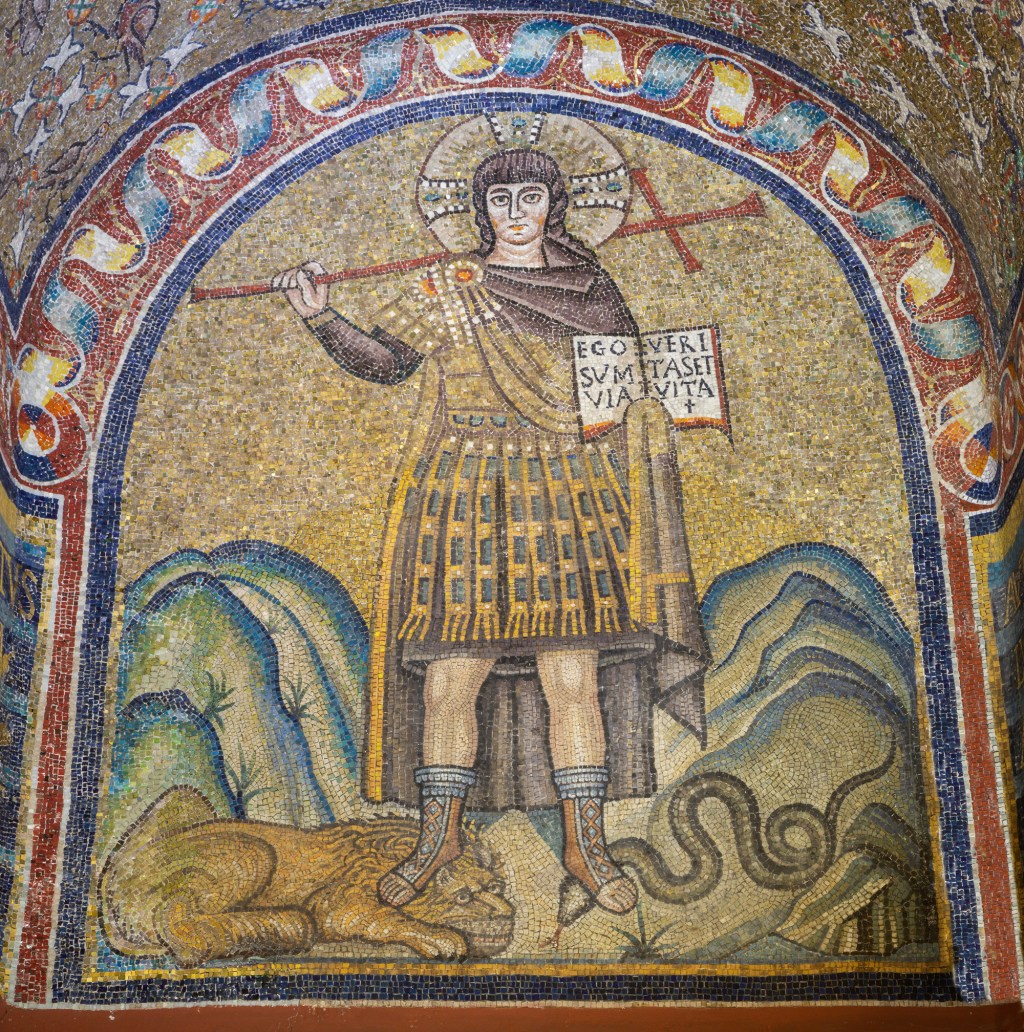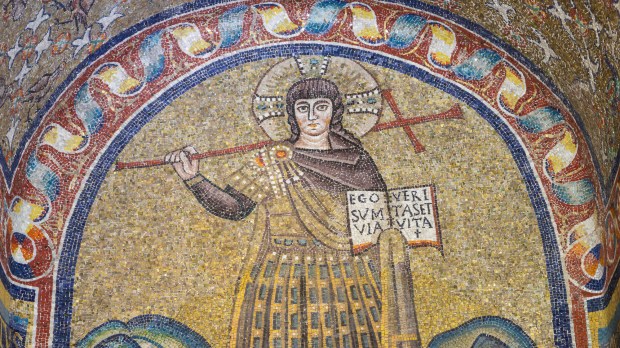The Gospel for the 5th Sunday of Easter opens with a powerful promise. Jesus encourages his disciples: “Do not let your hearts be troubled. You have faith in God; have faith also in me. In my Father’s house there are many dwelling places. If there were not, would I have told you that I am going to prepare a place for you? And if I go and prepare a place for you, I will come back again and take you to myself, so that where I am you also may be. Where I am going you know the way.”
But the words seem to backfire because the disciples’ worst insecurities suddenly kick in. The disciples don’t, they claim, know where Jesus is going; they do not know the way; and if only they will be shown the Father, then that will be enough for them. Our Lord’s response to all this is: “I am the way and truth and the life. Whoever has seen me has seen the Father.” This is a great gift and mystery.
It is represented in a glorious 6th-century mosaic titled “Christ Treading on the Beasts” found in the St. Andrew’s Chapel (the Archbishop’s Chapel) in Ravenna, Italy.

Show us the Father!
Philip’s plea voices something deep within us all. Show us the Father! The disciples recognize that what is incomparably exceptional about Jesus … the thing they find so irresistibly attractive, is his relationship with his Father. Philip’s entreaty expresses the most ardent longing of the human heart. It begs: Show us the One who knows the worst about us and who, with that knowledge, loves us all the more simply because we need to be loved more. Show us the One who refuses to become fatalistic about our failures and never loses hope in us. Show us the One who loves us simply because we are his. Because if we have that kind of love in our life, it will be enough for us.
Jesus’ response to our yearning is, “If you know me, then you will also know my Father.” The mosaic shows us how Jesus wants to be known.
“And you still do not know me?”
The artist of the mosaic goes out of his way to portray a super youthful Christ. Jesus is depicted beardless, boyish, wide-eyed, brawny, intrepid, and impressive. He has boldly crossed those mountains in the background in order to take on the world.
And even though the figure is so young, the artist garbs Jesus in a warrior’s uniform, like a Roman emperor on campaign. The military characterization of Christ is meant to make us think of him as an aquilifer — the prestigious officer set apart to carry and defend the legion’s standard in battle. The aquilifer was a particular soldier whom the commanding officer never lost sight of in battle … the one who constantly held aloft the standard for his co-combatants to see.
The standard that this Soldier hoists is the saving cross. But Jesus slings the cross on his shoulders like a ruddy high school athlete toting his lacrosse stick, with a face that says, “I’m ready for this match!” The Way who Jesus is is revealed in the way of the cross. Through the work of the cross we come to know Jesus and are shown the Father. “The cross is the disarming of self by which we give ourselves to God” (Fr. Bernard Bro). As St. Augustine enjoins, “Walk like this man and you will come to God. It is better to limp along on the way than to walk briskly off the way.”
So sacred and searing are the words I am the Way, the Truth, and the Life that Jesus in the mosaic dares not handle the book that bears them with a bare hand, but rather he takes up a fold of his regal cloak — like a humeral veil — to brandish the open Bible. What this declaration proposes calls for the all of ourselves. Notice that Jesus does not say, “I am the map, the opinion, and the career choice.” Our Redeemer offers us the Absolute … which requires on our part a response as all-encompassing, valiant, and fearless as our gallant Savior appears here.
Gazing upon the mosaic’s victory-bound glorious Son of God, we get caught up in the enthusiasm of St. Ambrose:
For Christ, to will is to do! Let us set out on this way, let us hold fast to truth, let us follow life. It is the way that leads us, the truth that strengthens us, the life that is restored to us through him. Yes, Lord Jesus, we do follow you, but we can only come at your bidding. No one can make the ascent without you, for you are our way, our truth, our life, our strength, our confidence, our reward. Be the way that receives us, the truth that strengthens us, the life that invigorates us.
The works of the Father
Jesus assures us, “The Father who dwells in me is doing his works,” and chief among those works is the work of redemption. Pope Benedict XVI described redemption this way: “Redemption is when someone has the experience of a great love in his life which gives a new meaning to his life.”
That redemption is symbolized in the mosaic in the Lord’s trampling the lion and the snake — images of the destructive forces and evil we face. The image recalls Psalm 91 — a staple of the Church’s Night Prayer (Compline).
You shall tread upon the asp and the viper;
you shall trample down the lion and the dragon.
In other words, what The Way, the Truth, and The Life does, we too are destined to do if we entrust ourselves to the way, the truth, and the life. Here’s how we will experience the great love that gives new meaning to life:
You have the Lord for your refuge;
you have made the Most High your stronghold.
No evil shall befall you,
nor shall affliction come near.
About Jesus being The Way, St. Thomas Aquinas says this mindbogglingly mystical thing:
When he, who is the way, goes to the Father, he is the way for himself. He is the way, and the one who goes by the way, and the destination of the way. Thus he goes to himself through himself. And so Christ, who is our way, became the way even for himself.
Aware of this, we are not surprised about the positioning of this mosaic in the archbishop’s chapel. The image has been strategically placed directly over the exit to the chapel, as if to remind the bishop always of his evangelical mission and to imbue him with The Way’s heroism and grace as he goes forth into the world.
Let’s do the same! United with Jesus … trusting in the Way, the Truth, and the Life … let’s keep our eyes on the One who holds high the cross for beholding, and let’s step over every lion and snake as we go to love the Father whom we have been shown.

